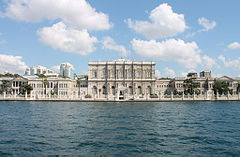
Dolmabahçe Palace (Turkish: Dolmabahçe Sarayı, IPA: [doɫmabahˈtʃe saɾaˈjɯ]) located in the Beşiktaş district of Istanbul, Turkey, on the European coastline of the Bosphorus strait, served as the main administrative center of the Ottoman Empire from 1856 to 1922, apart from a 22-year interval (1887–1909) in which Yıldız Palace was used.
The site of Dolmabahçe was originally a bay on the Bosphorus which was used for the anchorage of the Ottoman fleet. The area was reclaimed gradually during the 18th century to become an imperial garden, much appreciated by the Ottoman sultans; it is from this garden that the name Dolmabahçe (Filled-in Garden) comes from the Turkish dolma meaning "filled" and bahçe meaning "garden." Various small summer palaces and wooden pavilions were built here during the 18th and 19th centuries ultimately forming a palace complex named Beşiktaş Waterfront Palace. The area of 110,000 m² is confined by Bosphorus on the east side, while a steep precipice bounds it on the west side, such that after the building of the new 45,000 m² monoblock Dolmabahçe palace a relatively limited space has remained for a garden complex which would normally surround such a palace.
Dolmabahçe Palace was ordered by the Empire's 31st Sultan, Abdülmecid I, and built between the years 1843 and 1856. Previously, the Sultan and his family had lived at the Topkapı Palace, but as the medieval Topkapı was lacking in contemporary style, luxury, and comfort, as compared to the palaces of the European monarchs, Abdülmecid decided to build a new modern palace near the site of the former Beşiktaş Palace, which was demolished. Hacı Said Ağa was responsible for the construction works, while the project was realized by architects Garabet Balyan, his son Nigoğayos Balyan and Evanis Kalfa (members of the Balyan family of Ottoman court architects).
The construction was financed through debasement, by massive issue of paper money, as well as by foreign loans. The huge expenses placed an enormous burden on the state purse and contributed to the deteriorating financial situation of the Ottoman Empire which eventually slid into state bankruptcy with the subsequent establishment of financial control over the "sick man of Europe" by European powers.
Dolmabahçe Palace was home to six Sultans from 1856, when it was first inhabited, up until the abolition of the Caliphate in 1924: The last royal to live here was Caliph Abdülmecid Efendi. A law that went into effect on March 3, 1924 transferred the ownership of the palace to the national heritage of the new Turkish Republic. Mustafa Kemal Atatürk, the founder and first President of the Republic of Turkey, used the palace as a presidential residence during the summers and enacted some of his most important works here. Atatürk spent the last days of his medical treatment in this palace, where he died on November 10, 1938.
Today, the palace is managed by Milli Saraylar Daire Başkanlığı (Directorate of National Palaces) responsible to the Grand National Assembly of Turkey. The only way to see the interior of Dolmabahçe is with a guided tour.















No comments:
Post a Comment